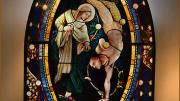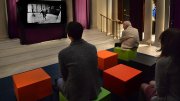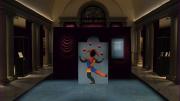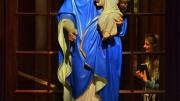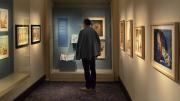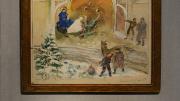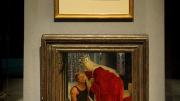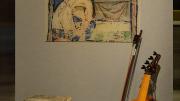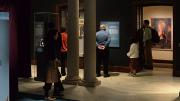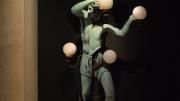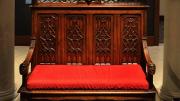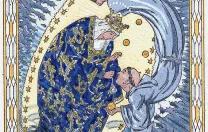The “Juggling the Middle Ages” exhibition, now open at Dumbarton Oaks, in Washington, D.C. (through February 28), plumbs the history of a medieval tale of a juggler’s devotion to the Virgin Mary; its rediscovery in 1873 and 1888 thanks to French medieval literary and philological studies; its subsequent popularization by Anatole France in 1890; and the utterly unlikely resonances and persistence of the tale today—from an American television version associated with Fred Waring (he of the Waring Blendor fame), to a staged version featured in Ebony and an operatic interpretation by W.H. Auden (The Ballad of Barnaby), illustrated by Edward Gorey ’50.
This almost madcap exploration through literary history has been lovingly conducted, curated, and brought to exhibition by Porter professor of medieval Latin Jan Ziolkowski, now in his third five-year term as director of the Dumbarton Oaks Research Library and Collection. Harvard Magazine has covered the underlying research and the astonishing reach of Ziolkowski’s collecting—of information and objects (ranging from sculpture to Christmas cards to children’s books based on the juggler story by Barbara Cooney, R. O. Blechman, and Tomie dePaola—the latter two of whom will speak at events being held in connection with the exhibition).
Visitors will find the exhibition radiating into four spaces from the Dumbarton Oaks entry, which is dominated by a newly commissioned stained-glass-window interpretation of the juggler, complete with vivid, three-dimensional yellow juggling balls. The history of the tale itself, in its medieval context, unfolds in a corridor to the left; that gives on to the great Byzantine room, now taken over, temporarily, by juggler exhibits, screenings of Blechman’s animated version of his story, plus TV and movie clips, and a collection of children’s books for visiting kids to read—while seated on oak benches inspired by medieval designs. A gallery next to the central hall features a number of those children’s books and other interpretations, including some of the original art later reduced for printing; miniature-book versions; and a lovely Jacob the Juggler, unlikely to be known to American audiences (translated by Ziolkowski and reprinted with support from Dumbarton Oaks), by the Swiss author Max Bolliger, stunningly illustrated with woodcuts by Czech-born artist Štěpán Zavřel. The perpendicular corridor is strong on operatic and other derivatives.
A final gallery, off the main reception room, captures the strong influence of medieval culture (of which the revival of the juggler’s tale was a part) on nineteenth- and twentieth-century arts, design, and books (and such sundry collateral products as advertisements for Pabst beer). It is good to be reminded that Henry Adams, A.B. 1858, included a translation of the juggler poem in Mont-Saint-Michel and Chartres. It is astonishing to see a 1906 version of The Song of Roland, from Houghton Mifflin, published in the form of a medieval illuminated manuscript: hard to imagine in the e-book era.
To anyone interested in the origins and dispersion of literature, its history, or the reach and potential of curiosity-driven humanistic research, these are among the rewards aplenty on display in Dumbarton Oaks’s magnificent spaces.
